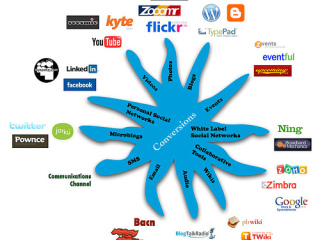

program. During the conversation, we discussed how to find time to
participate in multiple social networks, how today’s technology
luddites might some day consume information, using RSS, and what the
recent economic turbulence means for today’s startups and tomorrow’s
entrepreneurs. One of the questions I’ve been mulling in my head is the
future, and what glimpses we have today, in regards to what tomorrow’s
social media tools will have, barring the true development of anything
dramatic, like teleportation, or bending of the time/space continuum.
Mobile
In
my opinion, the advent and adoption of mini-computers masquerading as
cell phones is the first big step, and one we are seeing in a big way
with the market share growth of the iPhone, the newest BlackberryGoogle’s Android platform.
Just
yesterday, my wife and I brought our twins to her mother’s house, and I
was able to show my 80-year-old mother in law how, with my phone, I
could take a photo, and e-mail it to her, wirelessly. I showed her how
I could access all my e-mail accounts, how I could watch baseball
playoff highlights in high quality, or access all my bookmarks, so when
they were added to my laptop, they would reach the phone as well. And
when I told her the iPhone started at $300, she was surprised it was so
low.
As iPhones and other “true Web” capable mobile devices
become a bigger part of how we consume and interact with the Web, so
too will they become a greater part of how we consume and interact with
social media specifically. Your social network then becomes less some
thing that you interact with just when in front of a desktop or your
laptop, but from anywhere, helping to bridge the gap between “following
friends” and “real life friends”. Consequentially, the mobile interface
to sites like Facebook, Twitter, FriendFeed, Social Median, Strands and others will be just as important as the standard Web GUI.
Unified
I also believe you will really start to see a tying together of friends
and profiles across the different networks. Many different sites now
have ways for you to import your contacts from your many different
address books and e-mail accounts, and others integrate with Facebook,
so when your friends on that service sign up, you’re automatically
connected. But it’s not as seamless as it could be, and adding the same
friends over and over again can get tiresome when new services arrive –
not to mention copying and pasting your personal profile and attributes
repeatedly.
What should happen, and will in due time, I believe, is that groups like OpenSocial
or others, will find a solution by which you gain a friends repository,
identifiable by your single user name, which checks against the
database and auto-populates your friend base, assuming they have given
permission. Similarly, when joining a new network, I should be able to
point that network to a central profile I have built, which has all my
activity, from Twitter, Flickr, Google Reader and the rest, and would pull my data down from those services, rather than making me add them each one by one.
Transparent
I also believe that with growth of professional services like LinkedIn and Plaxo,
and increased awareness of tools to derive a person’s background, there
will be greater transparency and easier discovery of a person’s
background. I should quickly and easily know a person’s professional
profile, and their external online activity, which would take the
guesswork out of some initial relationships. While some might say this
would be too much a breach of privacy, and that anonymity is a
much-treasured aspect of the Web, the Generation Y Millennials have no
such expectations, and are all too willing to put their data out there.
Tomorrow’s tools will capitalize on this and further blur your online
persona with that you use at the office or at home.
I don’t want
to pontificate on smaller technology aspects, such as increased video
usage, location awareness, or even real-time language translations,
although each will be playing a part in these future services. Those
are for the experts in their respective field. But we can see these
aspects evolving. The world of social media is going to be unified,
transparent and mobile (or location independent). Those that can best
capitalize on the unification of data, and avoid the traditional walled
garden approach will be the winners.
(Image source: Webguild.org)















